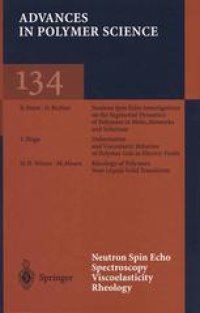
Ebook: Neutron Spin Echo Spectroscopy Viscoelasticity Rheology
Author: B. Ewen D. Richter (auth.)
- Genre: Chemistry
- Tags: Polymer Sciences, Condensed Matter
- Series: Advances in Polymer Science 134
- Year: 1997
- Publisher: Springer-Verlag Berlin Heidelberg
- Edition: 1
- Language: English
- pdf
Viscoelasticandtransportpropertiesofpolymersintheliquid(solution,melt)or liquid-like (rubber) state determine their processing and application to a large extent and are of basic physical interest [1—3]. An understanding of these dynamic properties at a molecular level, therefore, is of great importance. However,thisunderstandingiscomplicatedbythefactsthatdi?erentmotional processes may occur on di?erent length scales and that the dynamics are governed by universal chain properties as well as by the special chemical structure of the monomer units [4,5]. The earliest and simplest approach in this direction starts from Langevin equations with solutions comprising a spectrum of relaxation modes [1—4]. Special features are the incorporation of entropic forces (Rouse model, [6]) which relax uctuations of reduced entropy, and of hydrodynamic interactions (Zimm model, [7]) which couple segmental motions via long-range back ow elds in polymer solutions, and the inclusion of topological constraints or entanglements (reptation or tube model, [8—10]) which are mutually imposed within a dense ensemble of chains. Another approach, neglecting the details of the chemical structure and concentratingontheuniversalelementsofchainrelaxation,isbasedondynamic scalingconsiderations[4,11].Inparticularinpolymersolutions,thisapproach o?ers an elegant tool to specify the general trends of polymer dynamics, although it su?ers from the lack of a molecular interpretation. A real test of these theoretical approaches requires microscopic methods, which simultaneously give direct access to the space and time evolution of the segmental di?usion. Here, quasi-elastic scattering methods play a crucial role sincetheyallowthemeasurementofthecorrespondingcorrelationfunctions.In particular,thehigh-resolutionneutronspinecho(NSE)spectroscopy[12—15]is very suitable for such investigations since this method covers an appropriate range in time (0.005)t/ns)40) and space (r/nm [15). Furthermore, the possibilityoflabellingbyhydrogen-deuteriumexchangeallowstheobservation of single-chain behavior even in the melt.